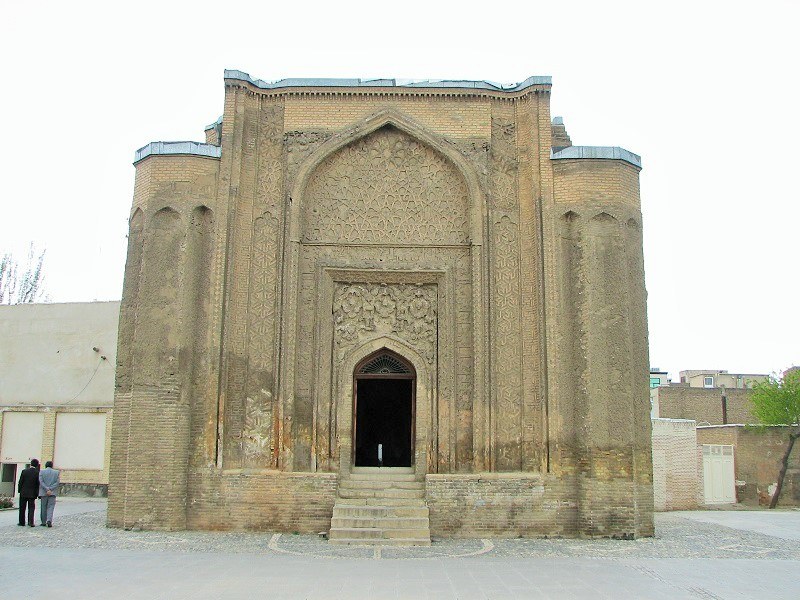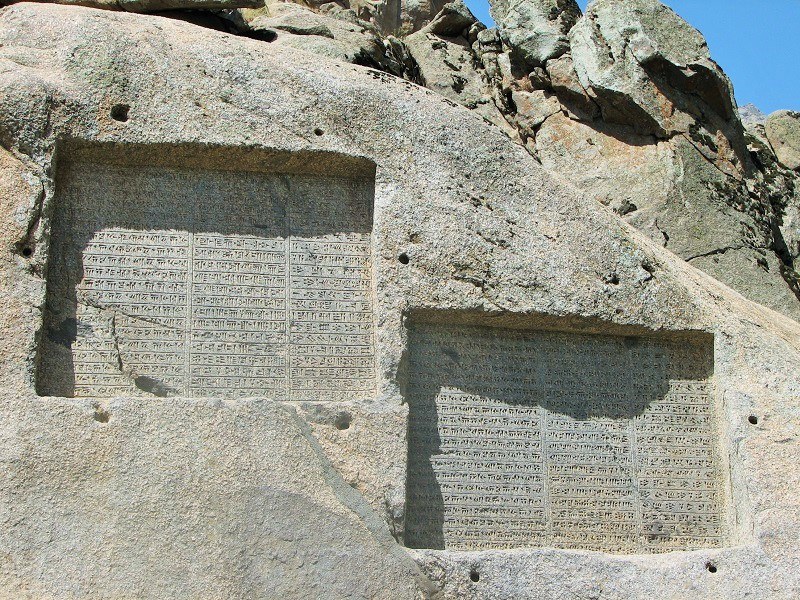
Hamedan (Hamadan) is one of the ancient cities in Iran offering several historical and natural attractions to world travelers. Many historians consider this city the capital of Iranian history and civilization.
A trip to this city will introduce you to a collection of historical monuments of different periods such as Ecbatana Historical City, Ganj Nameh Tourist Resort Complex as well as natural wonders like Ali Sadr Cave, etc. The visit to the traditional Bazaar of Hamedan and a selection of local spices and souvenirs is also amazing.
Geography of Hamedan
Hamedan Province is located in the west of Iran. The adjacent provinces are Zanjan and Qazvin provinces at the north, Lorestan at the south, Markazi at the east and Kurdistan and Kermanshah Provinces at the west.
Having a variety of religious, natural and historical attractions, Hamedan gets the attention of different groups of people with all kinds of tastes. The capital of Hamedan Province is the city of Hamedan, built during the Medes. At that time, the name of the city was Ecbatana and it was the capital of Iran.
The city of Hamedan is 2831 km2 vast and has an average height of 1820 meters above sea level. The Alvand mountain range overlooks the city from the east and south. This is the main reason for the high altitude of Hamedan resulting gin its mountainous and cold climate.
To travel to Hamedan, you can take a plane, interurban buses, private cars, and even trains. The airport of the city is about 5 km from this city. The bus terminal of the city is located on Enqelab Boulevard. To travel by train, you can also go to Malayer Railway Station and then, from there, travel to various areas.
Most people choose to travel by car. If you intend to travel from Tehran, the best choice is Tehran-Saveh and then, Saveh-Hamedan roads. Another route to reach Hamedan is via Bouin Zahra Road, as well as Qazvin to get there.
In general, the northern entry routes to this province, including Saveh to Hamedan and Zanjan to Hamedan, are the busiest ones.
Population and Economy of Hamedan
According to the 2016 Iranian Population and Housing Census, the population of the province of Hamedan was 1,738,234 people.
In 1985, Iran established the first large industrial town in Hamedan Province. Today, the city has got 17 such industrial towns.
Apart from industrial settlements, there are automotive parts factories, fitted carpet industries, cake, and chocolate factories, and glass factories, which are the major industrial units of the city.
Due to its geographical location, good climate, suitable soil and the presence of a creative and active workforce, Hamedan Province has many production potentials in the field of agriculture. In addition to providing the internal needs of the province, Hamedan supplies a part of the country’s agricultural needs.
This province is of the top rank in the production of walnuts, garlic, and potatoes. It is in the third rank in grape production and second in raisin production.
History of Hamedan
Archaeological excavations in the Gowdin Tappeh and Segavi historical mounds near Kangavar City, as well as Noushijan mound in Malayer, has led to the discovery of a part of the culture and civilization of Medes. This includes the first samples of the script and inscription, the first forms of the coin and the first manifestations of religious culture and Iranian architecture.
According to Herodotus, the Greek historian, at the end of the 8th century, Deioces, the founder of the Median government, led the Medes to achieve a political and military organization and establish the first powerful state of Iran’s plateau. Deioces chose Hamedan as his capital city and ordered to build great fortifications including the seven concentric walls, each one in a different color.
During the 150 years of the reign of the Medes, the city of Hamedan had great riches and abundance. After the fall of the Medes, though Hamedan lost its centrality, it was one of the three Achaemenid capitals.
The ancient inscriptions of Ganj Nameh, the remains of stone pillars, Achaemenid palaces, gold and silver cups and tablets found in Hamedan that dates back to this period indicate the importance of this city and region.
Stone Lion Statue and the remains of a cemetery in Hamedan and few remnants of Laodicea Temple in Nahavand City remain from the Parthian and Seleucid Empires. According to a book written in the Pahlavi language about the cities during the rule of Qobad (Kavad in approximately 500 AD), Yazdegerd founded Hamedan. This indicates that there were significant city developments at that time in ancient Ecbatana.
Around 2500 years ago, the Achaemenid Empire governed half of the ancient world, and Ecbatana was one of the two capitals of this great Empire. Darius I (522-486 BC) has left his second major inscription, after the inscription of Bisotun, as a legacy on the rocks of the sacred Mount of Alvand. After Darius the Great, his son, Xerxes I (486-466 BC), immortalized the same inscription with little changes with his name.
Historical Attractions inside the City
Here’s a list of interesting places to visit inside Hamedan:
Tomb of Baba Taher

The tomb of Baba Taher Oryan is a memorial building of the contemporary era. It is located on a raised ground in the northwest of Hamedan city in Baba Teher Square. Baba Taher lived in the 11th century. He was one of the great poets and mystics of his time.
Avicenna Mausoleum

The burial place of Avicenna is located in the city of Hamedan, in a square by the same name. In fact, this tourist destination is very valuable to diverse people, such as philosophers, doctors, and everyone who respects the forefathers of today’s sciences.
Ecbatana Historical Mound

Ecbatana is the name of an ancient city, which was the capital of Iran during the reign of the Medes. This city along with Athens and Rome are among the few ancient cities in the world that are still alive. According to the historical documents, Deioces founded Ecbatana City.
Alavian Dome

This is a unique example of post-Islam Iranian architecture. The site is located in Alavian Chaharbagh (four-garden), near the Imamzadeh Abdullah Square, in Hamedan. Alavian Dome is one of the masterpieces of architecture and stucco art after Islam in Hamedan.
Imamzadeh Hossein
Imamzadeh Hossein is located at the center of the city of Hamedan and at the beginning of Shohada Street. It is one of the distinguished architectural works of Hamedan with a beautiful brick dome is. According to the pieces of evidence, the construction of the building dates back at least to the Safavid era.
Qorban Tower

Qorban Tower is one of the historical monuments of the 13th or 14th century. It is located in the Zand neighborhood of Hamedan, between Chahar Baq-e Shahid Madani and Taleqani Street, near Avicenna high school. This building accommodates the tombs of Shaikh ol-Salam Hassan bin Attar Hafiz Abu al-‘Ala Hamedani and a group of Seljuk emirs.
Friday Mosque of Hamedan
According to Hegmataneh book, the architects built this mosque in the style of the mosques constructed in Tehran, Qazvin, and several other cities during the era of Fath Ali Shah, the Qajar king.
Tomb of Esther and Mordechai

The burial place of Esther and Mordechai is one of the exclusive historical attractions of Hamedan and shrines of the Jews of Iran and the world. This shrine was an important factor in the formation and continuation of the Jewish community in Hamedan.
Hamedan Traditional Bazaar
This historical market of the city is located near Baba Taher, Ekbatan and Shohada Streets. Most of the Bazaar buildings date back to the Qajar period. The traditional Hamedan Bazaar is roofed and some parts have dome-shaped roofs.
Hamam-e Qal’eh of Hamedan

It is a traditional bath located in one of the ancient and original neighborhoods of Hamedan called Qashoq Tarashan or Qal’eh neighborhood on Shariati Street. Hamam-e Qal’eh dates back to the Qajar period and has an area of 1500 m2.
Museum of Natural History of Hamedan

Hamedan Museum of Natural History is located at the end of Chahar Baq Street. There is a unique collection of various species of animals, plants and nature varieties related to the climate of Iran and the world.
Stone Lion Statue of Hamedan

The relics of the Stone Lion statue is an interesting piece remained from ancient times. It is in a quadrangular square where a lion-shaped statue is placed on a pedestal.
Historical Attractions outside the City
Here’s the list of the amazing sites to visit outside the city of Hamedan
Ganj Nameh of Hamedan

The sites where Ganj Nameh inscriptions are located are very close to the city. The inscriptions engraved on one of the cliffs of Alvand Mountain are located 5 km west of Hamedan, at the end of the Abbas Abad Valley. These relics are from Darius and Xerxes era, the kings of the Achaemenid Empire.
Kurijan Bridge of Hamedan
The Kurijan Bridge is located in Kurijan Village, in the Central District of Kabudarahang County, 22 km north of Hamedan. This bridge is constructed on the Qarachay River and the construction dates back to the Safavid period.
Tomb of Habakkuk the Prophet

One of the attractions of Hamedan Province is the tomb of Habakkuk the prophet located in the beautiful city of Tuyserkan. Tomb of Habakkuk the Prophet is one of the ancient tombs in Iran.
Natural Attractions of the City
Here’s a list of natural wonders outside Hamedan
Mishan Plain of Hamedan

This natural attraction used to be the summer residence of the Achaemenid kings in Hamedan. They had assigned it as the summer capital because of its pleasant weather.
Sarab-e Gyan

If you drive for half an hour from Hamedan to Nahavand, there is one of the most beautiful wetlands 20 km before you reach Nahavand called Sarab-e Gyan. It literally means Gyan Mirage, which is listed as an Iranian Natural Heritage. It is one of the most watery wetlands in Iran.
Ali Sadr Cave

In Ali Sadr Village, located in Kabudarahang County and 75 km northwest of Hamedan, one of the most beautiful natural caves of the world is located. It is a rare example of water caves called Alisadr Cave. Paddleboats are available for visiting inside the cave.













